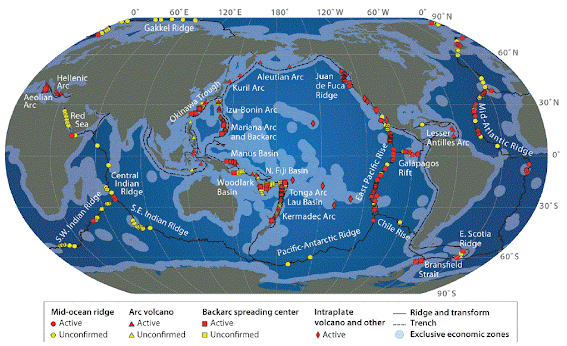What is a Hydrothermal Vent ?
A hydrothermal vent is a rift on the seafloor from which geothermally hot water combustions occur. Hydrothermal vents are typically found near volcanically active places, areas where tectonic plates are moving apart at dispersing centers, ocean basins, and hotspots. Hydrothermal deposits are rocks and mineral ore are deposits shaped by the effort of hydrothermal vents.
How hydrothermal vents are formed ?
Hydrothermal vents are the result of seawater percolating down through chasms in the ocean crust in the area of circulating centers or subduction zones (areas on Earth where two tectonic plates move away or towards one another). The cold seawater is warmed up by hot magma and reemerges to form the vents.
Why Hydrothermal Vents are important ?
- Hydrothermal vents act as natural plumbing systems that transport heat and chemicals from the interior of the Earth and that help regulates global ocean chemistry.
- Hydrothermal vents provide nutrients needed for ocean organisms.
- Microbes discovered at hydrothermal vents may also be vital to the improvement of medicines and other products.
- Hydrothermal vents also furnish a laboratory in which scientists can research changes to the ocean and how life on Earth could have started up.
Types of Hydrothermal Vents
There are
two types of hydrothermal vents;
- Black Smokers
- White smokers
- The hottest of the vents, the "black smokers", got their name as a result of spilling a dark "smoke" formulated especially of iron and sulfide. This mix forms iron monosulfide and provides the smoke its black color.
- The "white smokers" unleash a cooler, lighter material composed of compounds together with barium, calcium, and silicon.
Where the hydrothermal vents are located?
Hydrothermal Vents are found at a median underwater depth of about 7,000 feet. They are found in the Pacific and Atlantic Oceans and focused close to the Mid-Ocean Ridge .Hydrothermal vents are generally found close to volcanically active places, areas wherever tectonic plates are moving apart at spreading centers, ocean basins, and hotspots.
What chemicals do hydrothermal vents release?
- Copper, zinc, iron, sulphide, and hydrogen dissolve within the fluids.
- Hot fluids carrying dissolved metals get on my feet through crust.
- The hydrothermal fluids combined with cold, oxygen-rich saltwater.
- Metals and sulfur mix to make black metal-sulfide minerals.
What kind of animals live in a Hydrothermal vent ?
Lots of variety of animals are living within the hydrothermal vents around the world. At a hydrothermal vent, there's no daylight to generate energy. Bacteria-like organisms named archaea have solved this difficulty by using a method called chemosynthesis to turn chemicals from the vents into energy. But hydrothermal vents help numerous species of marine life, such as fish, tubeworms, clams, mussels, crabs, and shrimp.
- Some of the unbelievable organisms that are living in hydrothermal vents are as follows;
- Tube Worms
Riftia pachyptila, usually known as the large tube worm, could be a marine invertebrate within the phylum Annelida associated with tube worms normally found within the seacoast and body of water zones. R. pachyptila lives on the ground of the Pacific Ocean getting ready to hydrothermal vents, and may tolerate extraordinarily high sulfide levels.
2. Gastropods
3. Zoarcid Fish
These
two-foot lengthy white fish are prime predators around hydrothermal vents.
They eat everything from tubeworms to shrimp. Despite their large
appetites, these fish are sluggish and lethargic. They expend a lot
of time floating around lumps of tube worms and mussels.
4. Deep Sea Vent Octopus
One tricky predator that lives among the vents however isn't usually seen is the deep ocean vent octopus, that mainly feeds on crabs and smaller crustaceans. These octopus are typically one meter long and their heads are about the size of an orange.
5. Kiwa Crabs
Crabs belonging to the genus Kiwa are an extensive marine animal that dwells close to hydrothermal vents. They nourish primarily on the substantial chemotrophic bacteria staying in their ecosystem. Interestingly, these crabs have been known to rhythmically wave their appendages in an undertaking to enhance the flow of methane and hydrogen sulfide from the vents. This improves the amount of food available to the bacteria and maintains the crab's main food supply abundant.
How long do hydrothermal vents last ?
Some vent fields might stay active for about 10,000 years, however individual vents are short-lived. Chemosynthetic bacteria get energy from the chemical bonds of sulphide. In hydrothermal vent communities, these microorganism area unit is the primary step within the organic phenomenon.










